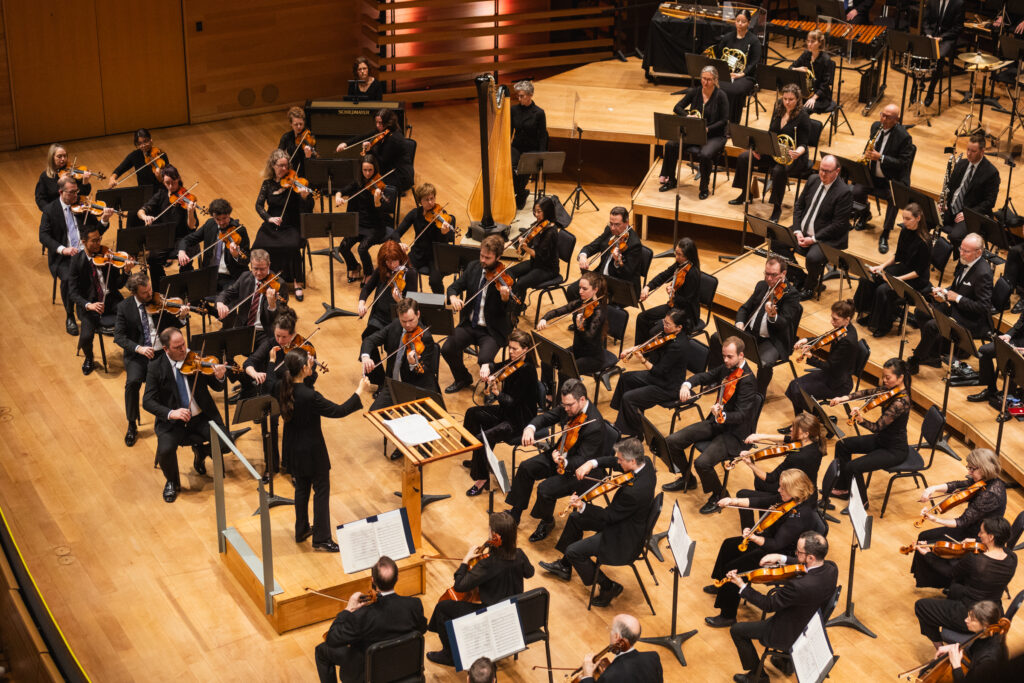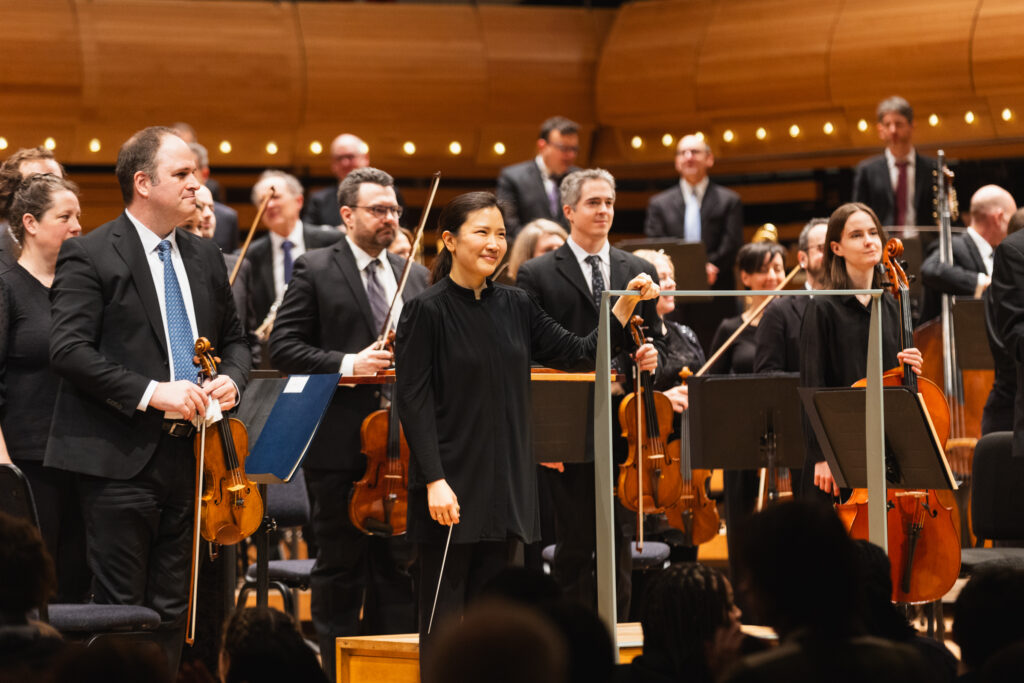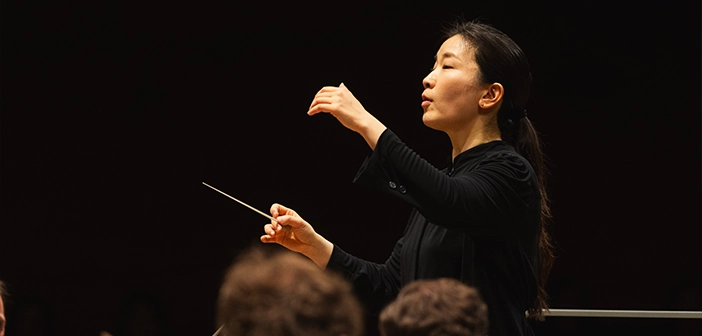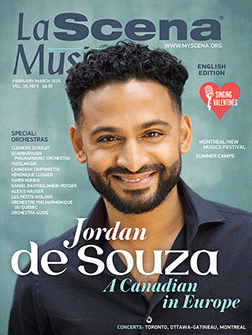On Thursday, Feb. 15, the Montreal Symphony Orchestra (MSO) presented a matinée concert at the Maison Symphonique. Maestra Eun Sun Kim, conductor of the San Francisco Opera, and local favourite, pianist Louis Lortie, joined forces for a program of works for piano and orchestra. Exploiting a variety of musical forms, the concert included repertoire standards, such as Brahms’s Variations on a Theme by Haydn, Op.56a and Mussorgsky’s Pictures at an Exhibition, as well as little know gems for piano and orchestra by Mozart and Fauré.
Johannes Brahms’ set of eight variations and a finale were originally written for two pianos, and orchestrated by the composer in 1873. The piece marks Brahms’ first foray into orchestral writing.
Uniquely included as the final movement at the performance of an early piano concerto in 1782, Wolfgang Amadeus Mozart subsequently used his Rondo in D major K.382 as a stand-alone piece showcasing his own remarkable virtuosity. Based on an original version for piano solo, Gabriel Fauré orchestrated his Ballade pour piano et orchestre op.19 at the recommendation of Franz Liszt. Better known in the form of Maurice Ravel’s exquisite orchestral arrangement, Modest Mussorgsky’s Pictures at an Exhibition was originally composed for piano, and remains a staple in the instrument’s repertoire. The creative combination of these pieces provided a balance between novelty and audience favourites.
The public welcomed veteran concert pianist Louis Lortie with enthusiasm as he stepped onto the stage, in an unassuming, approachable manner. Under Maestra Kim’s balanced conducting, the orchestra’s tone complemented Lortie’s shimmering, pearly, and exquisite pianistic timbre. Relying on his wonderfully innate sense of phrasing, shape, and musicality, Lortie easily expressed the elegance and drive of Mozart’s rarely heard Rondo. Given the hall’s acoustic properities, Lortie made generous use of the pedal to find the appropriate resonance and colours on the Bösendorfer concert grand.

Montreal Symphony Orchestra (Photo by Gabriel Fournier)
Lortie’s romantic sensibility and classical refinement made for an ideal pairing in Fauré’s Ballade op.19. In the master pianist’s hands, the work sounded natural, balanced, and exquisite. Inspired by their guest, the orchestra found its true colours: a suave, shimmering string section blended with the winds and brass to produce a uniquely French sound. The piano part reflected the characteristics of Fauré’s mother tongue: rich vocabulary, picturesque images, the interplay of sound, rhyme, and colour.
The program’s pièce de resistance was, not surprisingly, Mussorgsky’s Pictures at an Exhibition. Led by the even-keeled Kim, the work’s opening, Promenade, resonated with a round, polished, and balanced tone from the brass section. The orchestra started off somewhat tentatively as evidenced in Gnome: instead of being taunted by a devilish and jeering little creature, the audience heard a patched-up display of orchestral techniques. The movement requires some risk-taking, along with character and imagination, which were lacking.
Nevertheless, Kim’s reliable beat, control, and coolness proved useful as the orchestra suddenly opened to its full potential under Il Vecchio castello. Spearheaded by Paul Merkelo’s inspired solos, the MSO delivered an excellent rendering of Tuileries. Ballet des poussins, Limoges, Cum mortuis in lingua mortua, and Baba Yaga were chilling in their delivery, depth, and excitement. Lagging slightly in Samuel Goldenberg et Schmüle, and during the transition between Baba Yaga and the Grande porte de Kiev, the MSO gave a convincing and powerful delivery of the Russian masterpiece.

Montreal Symphony Orchestra (Photo by Gabriel Fournier)
The successful second half of the concert made up for a less compelling opening. Having heard Brahms’s Variations in its two piano version several times, the performance of the work by the MSO raised questions: is the work classical or romantic? Straddling both worlds, Brahms provides a potentially unsolvable puzzle to modern-day conductors, who must choose between emphasizing the works classical elegance and refinement or, alternatively, exploiting the lush romantic textures, instrumentation and phrasing found in most variations. Unfortunately, neither Kim nor the orchestra seemed to make an assertive enough choice, either way.
While Brahms’s instrumentation does not fit the requirements of a classical orchestra, the work awkwardly hinges on its Haydn-esque theme and character. Kim’s precise, controlled, and contained conducting style seemed aimed at emphasizing these qualities. The MSO’s sound leaned more towards the romantic, however. Exploiting the full romanticism of the piece, in this case, might have been the better approach.
While the performance was beautiful and the conducting technically irreproachable, the interpretation lacked a clear orientation. The public intuitively responded with proportionately lackluster applause.
Despite the tentative beginning, the concert broke the ice for the next two performances which will be held tonight at 7:30 pm and Saturday, Feb. 17 at 2:30 pm: https://www.osm.ca/en/concerts/mozart-and-faure-with-louis-lortie-and-eun-sun-kim/














